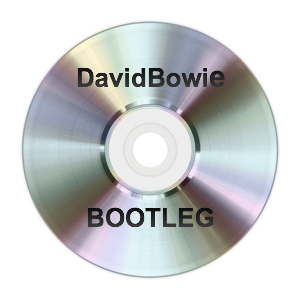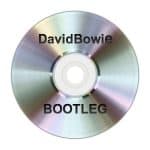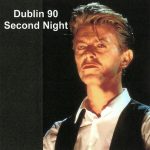David Bowie 1990-08-09 Dublin ,The Point Depot – First Night at The Point Depot Dublin 1990 –
Sound Quality Rating
01. Annoncement – Ode to Joy.flac
02. Space Oddity.flac
03. Rebel Rebel.flac
04. Ashes To Ashes.flac
05. Fashion.flac
06. Band Introduction.flac
07. Life On Mars.flac
08. Pretty Pink Rose.flac
09. Stay.flac
10. Blue Jean.flac
11. Let’s Dance.flac
12. Sound And Vision.flac
13. Ziggy Stardust.flac
14. China Girl.flac
15. Station To Station.flac
16. Young Americans.flac
17. Suffragette City.flac
18. Fame.flac
19. “Heroes”.flac
20. Changes.flac
21. White Light White Heat.flac
22. Jean Genie – Gloria.flac
Label : No label
Audio Source : audience
Lineage : 2 x C90 Cassettes (low gen , possibly 3rd.)
Taper: ???
Recording Location: ???
Total running time : 1:33:52
Sound Quality : noise ,dull ,but still good listened to
Attendance : 15.000
Artwork : None
9 and 10 August 1990 at The Point Theatre, Dublin
Review: Dave Fanning
This was better than anyone expected, and at least as good as we’d hoped. With an awesome yet deceptively simple stage show designed for outdoor arenas or at least for venues that can hold 15,000 plus, Irish fans were treated to the best in sound and vision from the man who electrified the ‘70s and who, let’s face it, has slummed it throughout the ‘80s.
But the self-importance of presenting a “Greatest Hits” package did not manifest itself in the form of half-hearted renditions of perpetually resonant songs or embarrassing attempts at high-concert dramatics.
Instead, Bowie felt he had a right to give a selection from his impressive scrapbook, honest, impassioned and sometimes crudely-honed (usually courtesy of guitarist,
Adrian Belew) interpretations. The result was usually electrifying and often exhilarating.
From the opening – an acoustic driven “Space Oddity”, delivered more as a basic song than some sort of prophecy – he set the standard for the evening. “Rebel Rebel” and “Ashes to Ashes” followed and we all settled down to the most satisfying rock cabaret we are ever likely to see.
The silk screen, lowered and raised repeatedly, predominantly featured enormous projected images of Bowie and a female dancer. Technically, this was pretty awesome and thankfully, it was never intrusive.
The music was always upfront and the sheer spectacle which was rounded out by the industrial stage props and the huge TV screens at either side (which, incidentally, were comically over-the-top in the perfect synchronicity stakes) left Bowie driving a stake through the heart of The Glass Spiders.
The music always had a very definite sense of historical authenticity. He was able to shift personae without relying on costume changes or physical manipulation and the stylish period touches were well judged.
Overall, there are reasons to be cynical, especially when discussing sequencers, samplers and tapes, but I wasn’t in a cynical mood and I’m going back for more tonight.
David Bowie Tour band 1990 – Sound+Vision Tour
Bowie specifically chose a smaller band for the tour, saying in a contemporary interview that “It’s a much smaller sound. It’s not quite as orchestrated as any of the other tours. The plus of that is that there is a certain kind of drive and tightness that you get with that embryonic line-up, where everybody is totally reliant on the other two or three guys, so everybody gives a lot more”
• David Bowie – vocals, guitar, saxophone[
• Adrian Belew – guitar, backing vocals, music director
• Erdal Kızılçay – bass guitar, backing vocals
• Rick Fox – keyboards, backing vocals
• Michael Hodges – drums
[real3dflipbook id=”3″]![]()
.
Ireland held a special place in Starman’s heart and head
David Bowie’s career was in a fraught state when he stepped on stage at the Baggot Inn in Dublin in the summer of 1991. After a run of mediocre albums, the 44-year-old’s reputation had sunk to a historic low. He was widely regarded as a washed-up crowd pleaser – Phil Collins with better hair and a tad more charisma.
But Bowie was not one to slink quietly into irrelevance and it is arguable the two shows he played in the capital that August – performing at the now defunct Waterfront several days later – marked the beginning of an artistic resurgence that would reach dizzying peaks through the 1990s.
He’d been in town rehearsing with his band Tin Machine – a hard-charging project Bowie hoped would serve as a restatement of his experimental rock credentials. But while that undertaking was to quickly burn out and fade away, the cathartically loud and impassioned turn Bowie put in at the Baggot Inn was an unmistakable declaration of intent. Among a sprinkling of new Tin Machine tracks, he cranked out a cover of Pixies’ ‘Debaser’ – a snarling pop song with arsenic in its veins. The message was unmistakable: Bowie wasn’t going to slink quietly into the night.
Over the next several years, it would become clear Ireland – where he had not even played until his 1987 Slane Castle concert – now held a special place in his affections. He became a frequent visitor, staying at Bono and The Edge’s Clarence Hotel and enjoying late nights at Lillie’s Bordello.
There were some knockout concerts too – intimate shows at the Olympia and HQ on Middle Abbey Street. It is significant Bowie chose Dublin to record his definitive live album, 2010’s ‘A Reality Tour’ – wherein he blazed through his catalogue and, with hilarious inappropriateness, closed out ‘Rebel Rebel’ with a flailing stab at pronouncing “Tiocfaidh ár lá”.
How far he had come from Slane, where Bowie had brought his much-mocked ‘Glass Spider’ tour in July 1987. By then, Bowie had reached peak “rock star” and was teetering towards self-parody. He’d moved conspicuously away from Ziggy Stardust’s sexually fluid glam-pop and seemingly renounced the damaged art-rock of his Berlin phase. Instead, he rolled into Slane and his Irish debut as just another chart idol – a smooth-crooning contemporary of Robert Palmer and George Michael, packing a trove of eager-to-please anthems.
Not that ‘Glass Spider’ lacked ambition or bombast. There were spoken word segments; a ‘rock v reality’ overarching theme and an eye-popping set-piece in which Bowie was lowered from the creaking “glass spider” set as he creakily crooned the tune of the same name. “Pepsi sponsored the whole thing,” wrote ‘Rolling Stone’s Andy Greene. “And some nights Bowie seemed to be sleepwalking through his hits. Guitarists Carlos Alomar and Peter Frampton didn’t always mesh well together, and the giant spider hovering over the stage did look a little ridiculous.”
Four years later, eager to make amends for his embarrassing (as he saw it) stint as a mainstream entertainer, Bowie installed himself at Factory Studios on the docklands for intensive rehearsals ahead of a tour promoting the second Tin Machine LP, ‘Tin Machine II’. There were six unofficial performances at the Factory, plus those soon-to-be-legendary gigs at The Baggot Inn and Waterfront.
Attendees at the Baggot recall Bowie walking through the crowd, asking uber-fans for a cigarette light. It was a pinch yourself moment for those who’d secured a ticket – and also a signal Dublin was achieving international recognition as a cultural centre.
Where Bowie came, British stag parties and American multi-nationals were soon to follow. Bowie hardly invented the Celtic Tiger – still, he was among the earliest to recognise something was stirring in Ireland.
Between Slane and the Factory rehearsals, he had played his first indoor gig here, in August 1990.
It was a two-night stop-off at the Point Theatre and Bowie was theoretically retiring his catalogue. As per its billing, the ‘Sound and Vision’ tour was stuffed with smashes – from formative classics such as ‘Space Oddity’ to the more commercial ‘Modern Love’ and ‘Let’s Dance’.
He would return to the Point in November 1995, with Morrissey in tow as support act. This time Bowie was looking forward rather than gazing over his shoulder.
He had released ‘Outside’, arguably his strongest record since 1980’s ‘Scary Monsters’. Although devotees would have been happy with an evening of catalogue favourites, Bowie was determined to showcase his edgy and tumultuous new direction.
There was some grumbling in the bleachers as he plunged into 90-plus minutes of torrid art-rock – though even the most trenchant holdout was probably mollified when Bowie reached for ‘Moonage Daydream’, a highlight from ‘The Rise and Fall of Ziggy Stardust and The Spiders from Mars’.
Yet for many Irish Bowie-philes it was his August 1997 two-evening residency at the 1,200-capacity Olympia that would rank as his definitive performances here. Modelling a scraggy goatee and oversized white jacket, Bowie was in cracking form, delivering a two-and-a-half-hour set both nights that encompassed all phases of his career.
One excited audience member went so far as to whip off her top and fling it at Bowie’s feet. “‘Allo mum,” he wisecracked without missing a beat. Earlier that year, he’d given another warm-up show to several hundred at his old Factory stomping ground. Tickets cost a tenner and punters were rewarded with a three-hour show.
Two years later, Bowie was back again for a brace of rare club gigs at HQ on Middle Abbey Street. Almost close enough to touch, he stepped with twinkling good-humour between classics such as ‘Life On Mars?’ and ‘Rebel Rebel’ and introspective tracks like ‘Thursday’s Child’, one of the earliest Bowie compositions that found the singer contemplating his own mortality and the ravages of a life often lived in the fast-lane.
Yet it’s Bowie’s final Irish performances that will take on the greatest poignancy following his death. In November 2003, he delivered two dates at the Point and was so chuffed with the results he released them as the ‘Reality Tour’ live album and DVD.
Those who missed those shows – this writer included – were mollified by the announcement he would headline the 2004 Oxegen festival. But in June of that year he suffered a heart attack and hung up his mic. All we were left with were ticket stubs, memories and the certainly we would never see Bowie’s like again.
Irish Independent



